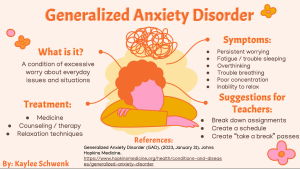Empowering Minds: Nurturing Mental Health in Schools
By incorporating mental health into the classroom, educators can increase awareness, empower students to prioritize their mental well-being and foster a supportive environment for students’ well-being and academic success.
I decided to focus on Generalized Anxiety Disorder, also known as GAD. Below, I have inserted a Google Slide where you can learn about what the disorder is, the symptoms, treatments, and some suggestions for teachers.
As a future educator, encouraging students to share their thoughts and feelings is crucial in helping them manage their mental health, including generalized anxiety disorder. I will make sure to create these opportunities for each of my students by having group discussions or one-on-one sessions. I will also make sure to encourage helping others, reinforce positive behavior, and learn more about mental health to support the students in my classroom, and all members of the school community.

References:
For educators. (n.d.). SAMHSA. https://www.samhsa.gov/mental-health/how-to-talk/educators
Generalized Anxiety Disorder (GAD). (2023, January 31). Johns Hopkins Medicine. https://www.hopkinsmedicine.org/health/conditions-and-diseases/generalized-anxiety-disorder
How to support your students with classroom anxiety. (2021, February 19). Tulane School of Professional Advancement. https://sopa.tulane.edu/blog/how-support-your-students-classroom-anxiety
Hi Kaylee! First, I want to point out the creativity and professionalism of your slide design. It looks fantastic! I think that you bring up a great point when you mention having a classroom environment where the students are encouraged to share their feelings. It is so important for us as future educators to help the students feel safe and free to speak their minds. Generalized Anxiety Disorder is something I did not know much about, and your slide helped educate me a lot. I really like your suggestions for teachers, as it helps open my eyes to methods of helping future students I have with this issue. Scheduling and breaking down assignments are great ideas to help students cope with anxiety. Do you think that students would take advantage of the “take a break” passes? I think it is a good idea… just as we all know sometimes students like to bend the rules; so I am curious how that would play out. Overall, I think you did an amazing job with your slide. Thank you for educating me on GAD and keep up the great work!
Hi Ben! Thank you for your thoughtful feedback! Regarding the “take a break” passes, I understand the point you brought up about potential misuse or students trying to bend the rules. Implementing this system requires clear communication and a set of rules to ensure students understand the purpose of these passes and when they are appropriate to use. With proper guidance and reinforcement, I believe students could benefit greatly from having the option to take breaks when needed. Thank you again for your feedback and encouragement!
Hi Kaylee, excellent work on both your slide and your blog post! What really caught my eye, and the part that I felt was the strongest part of your work is how engaging and captivating your slide is. You were able to efficiently organize the information regarding your disorder, allowing your readers to truly grasp what this mental illness entails and how we as educators can work to alleviate some of the symptoms that students may face. Tying this topic back to our previous modules, did you consider how perhaps issues such as cyberbullying and diversity affect students with generalized anxiety disorder differently, or perhaps, even cause this disorder to arise? Many times, students of diverse backgrounds may suffer from generalized anxiety disorder and other mental illnesses as they try to navigate life and situations in which they may see themselves as the “other”, or as not being able to fit in. I think that as educators, we must take into account all of these aspects which may affect our students, doing our best to address these issues and minimize their impact on individuals, as you mentioned. One suggestion I’d like to present is: how could you begin to talk about this disorder with your students, so that they know what symptoms to look out for and when to come to you, as an educator, for advice? It is important to not only let your students know that the resources are available to them, but to learn how to evaluate their emotions and decide when is the right time for them to reach out for support and guidance. Overall, great post, I really enjoyed reading it and learning what this disorder entails.
Hi Maylen! I’m glad to hear that you found both the slide and blog post engaging and informative. I agree 100% that discussing the disorder with students is crucial. Creating a safe and open environment where students feel comfortable discussing their emotions and seeking support is essential. Implementing discussions about mental health and providing resources for students to recognize symptoms and know when to seek help are steps I plan to integrate into my teaching approach. Additionally, by acknowledging students from diverse backgrounds, bullying, and everything stated in the past modules, GAD could likely arise from these behaviors. It is essential for us as future educators to foster a sense of belonging and acceptance among all students, regardless of their background, while also providing resources and coping strategies since the sense of not fitting in could complicate their mental health struggles. Thank you for your feedback!